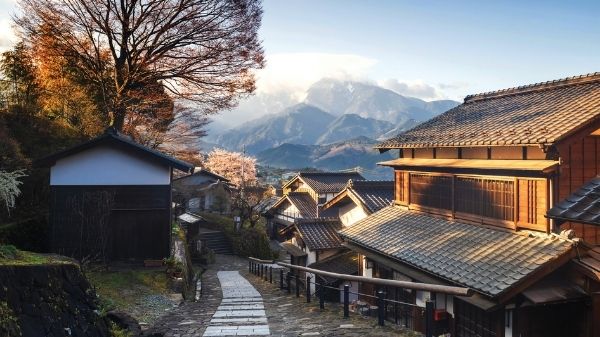“The historic Nakasendo Trail is now one of Japan’s most popular non-urban tourist attractions”
Constructed upon ancient foot trails, the Nakasendo highway (literally “central mountain route”) connects the Nihonbashi Bridge in Tokyo with Kyoto’s Sanjo Bridge. Beautifully engineered and lined with verdant forests, this 534km trail was originally intended for foot traffic between the two cities. Inevitably, the intervening centuries – particularly those subsequent to the fall of the Tokugawa shogunate in the late 19th century – had seen these roads fall into ruin. Fortunately, back in the ’60s, the Japanese government, recognising their historic and cultural value, set out to entirely restore the wooden buildings along these venerable routes to their original glory.
Today, thanks to such renovations, as well as the introduction of a contemporary tourist-friendly infrastructure, these ancient walkways are once again welcoming curious travellers from around the world. In addition to the concrete roads that criss-cross the landscape, there are also several train tracks that ferry footsore tourists to various hubs along the route via high-speed trains. This allows visitors to not only choose just which venerable attraction they wish to visit, but also to tailor hikes according to their temperament and ability.
A popular starting point is Magome, the 43rd of Nakasendo’s 69 post towns, which is situated three hours’ train ride from Tokyo. Framed by verdant peaks, the sleepy streets of this heritage destination are lined with numerous tea shops, ryokans (traditional Japanese guesthouses) and even offer a souvenir shop or two. The latter feature much the same ware that has been sold here for generations – lacquerware boxes, dried fish and sake from local distilleries. Many also drop by the Wakihonjin Museum to learn more of the town’s history, before popping into the Honjin / Toson Memorial Museum, a former inn that is now a memorial to locally-born Shimazaki Toson, a highly regarded Japanese literary figure.
A mere 7km from Magome, along a relatively gentle and well-marked trail crossing the the picturesque Kiso Valley, lies Tsumago, considered by many to be the trail’s crowning jewel. Thanks to the considerate restoration efforts, which saw TV antennae lopped away, electricity lines buried and cars banned during daylight hours, this beautifully preserved town is – visually at least – identical to its original Tokugawa incarnation. A charming, wholly photogenic village, it is once again punctuated by rows of traditional Japanese wooden houses, shops and ryokans. Even the mailman has to wear period-specific attire.
If you’re not too exhausted by the three-hour hike from Magome, Tsumago boasts several unmissable attractions, including the Nagiso Museum of History, a showcase of the town’s extensive restoration process. The ruin of Tsumago Castle, meanwhile, though all but lost to the ravages of time, is the perfect spot to snap a photo or two, largely on account of its breathtaking views out over the town and neighbouring Midono-juku. If you’re keen to sample the local cuisine, check out Yoshimura Soba, a popular eatery renowned for its homey soba noodles, before stopping off across the street for some old-fashioned matcha tea and mochi.
Further along Kiso Valley lies the third of the historic trail’s trio of must-visit destinations – Narai. Located at the foot of the Tori Pass – one of the more demanding stretches of the Nakasendo highway – this was once the most prosperous of the post towns. Known as ‘Narai of a 1,000 Inns’, its long main street is dotted with various ryokans and minshuku, family-operated traditional Japanese bed-and-breakfasts. There is also the inevitable array of souvenir shops, all peddling wood carvings and dried fruit. Those wishing to relax aching muscles and sore feet should also venture into the hot springs (onsens) for a soak in one of the naturally-heated pools.
Though there are other notable destinations along the trail, these three iconic post towns offer the most authentic Nakasendo experience. Unusually well-preserved, they give avid hiking enthusiasts (of every level of accomplishment) the chance to relive the glory days of the Tokugawa era by walking in the footsteps of the samurai of times classic, an opportunity rarely accorded and one not to be missed.










